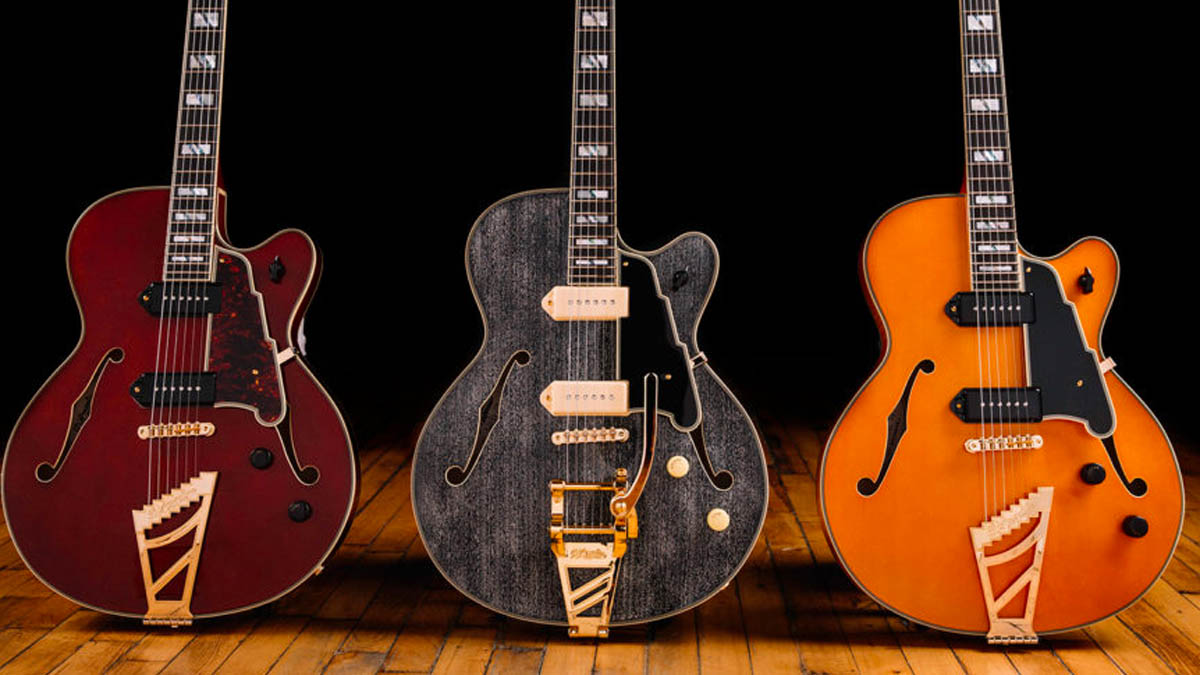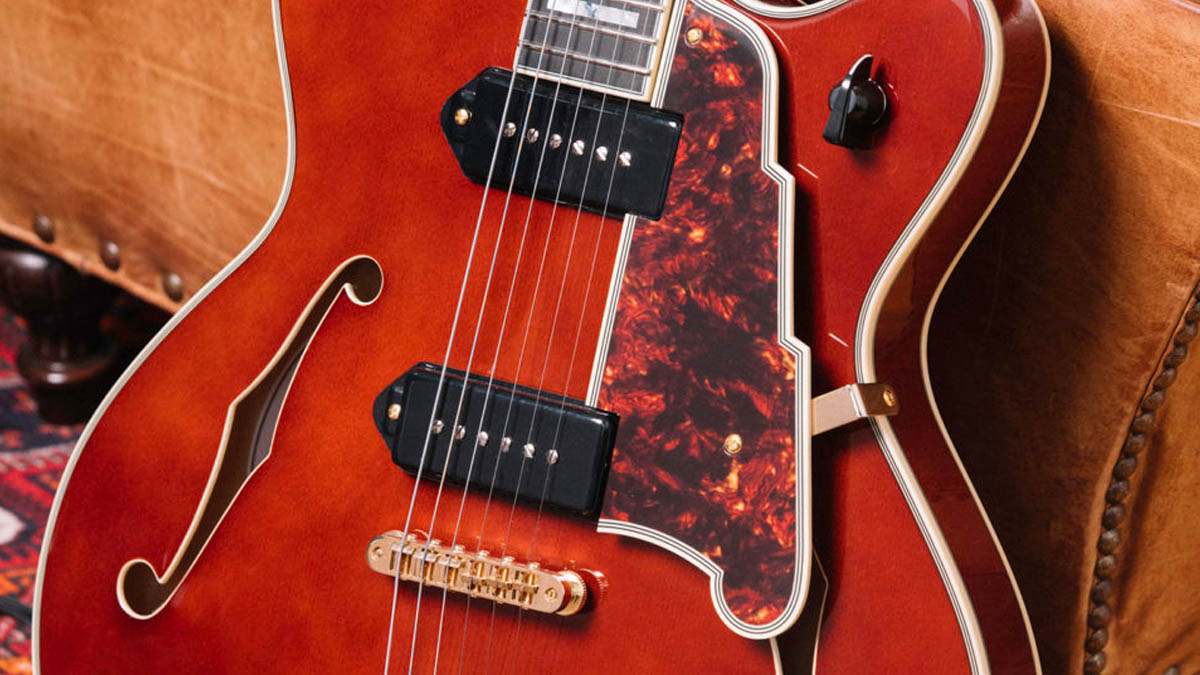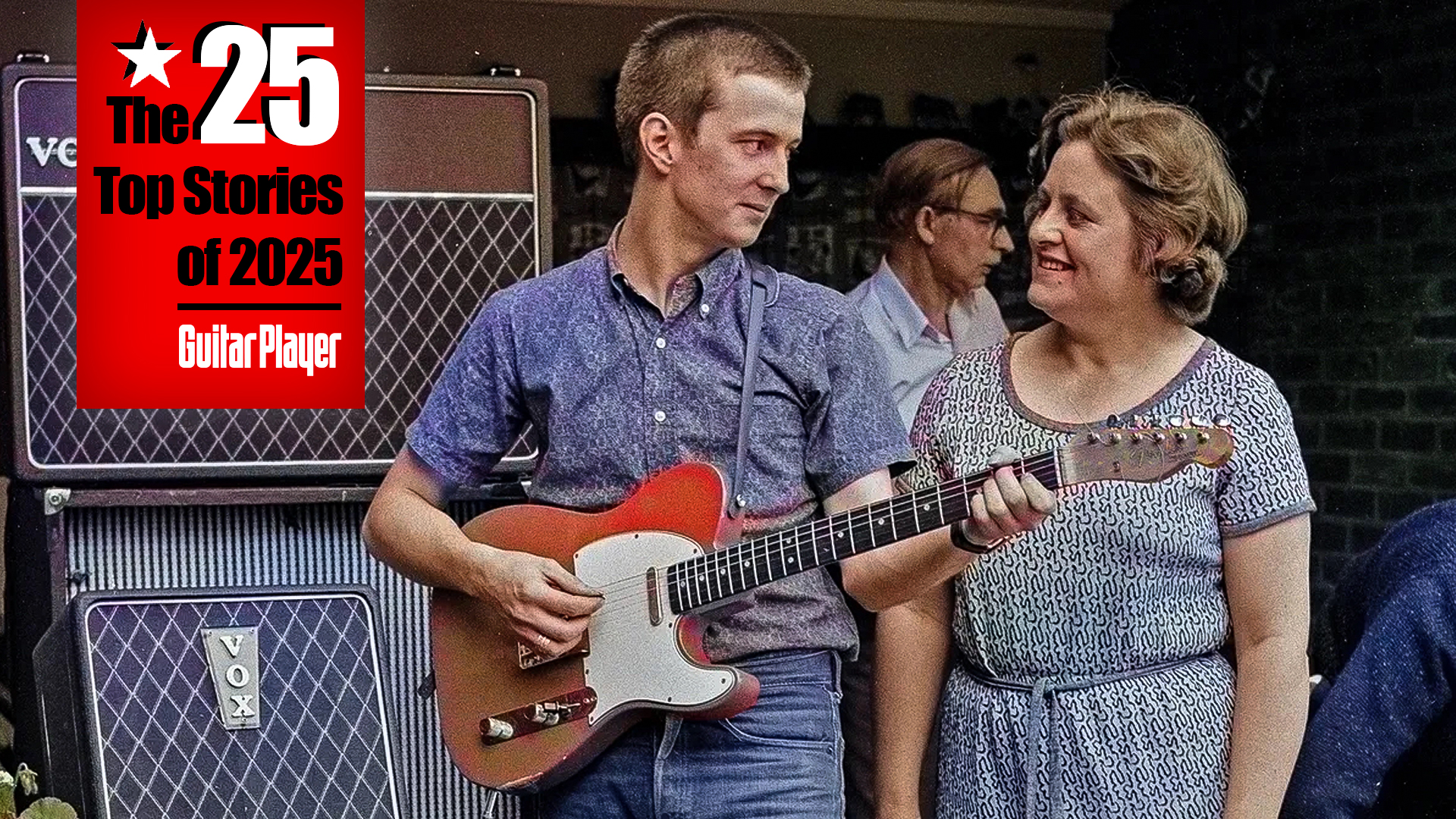GuitarPlayer Verdict
A well-built and cleverly-conceived redux of a classic D’Angelico model.
Pros
- +
Handsomely decorated.
- +
Delivers great tone.
- +
Easy playability across a surprisingly broad range of styles.
Cons
- -
For some, the three-way rotary pickup selector might impede quick position changes.
You can trust Guitar Player.
Having put its elaborate headstock on a range of creative solidbody offerings in recent years, as well as a large selection of semi-hollow and fully hollowbody electric guitars, the revived D’Angelico brand has reimagined a classic from the glory days of its namesake, John D’Angelico, in the new Excel 59.
The flat front view might imply a period-correct take on the legendary New York archtop maker’s cornerstone Excel model of the late ’50s – something already available in the existing Excel EXL-1 model – but a thinline (though still fully hollow) body and other contemporary features help to make it a more timeless creation, and likely broaden its appeal for the contemporary player.
Although the Excel 59 looks and feels pretty big, its 16-inch-wide body is a couple inches smaller than the biggest jazz boxes of the golden age, and it’s on par with the ES-335, though a little deeper – 1 7/8 inches – at the rims.
It’s made from laminated flamed-maple back and sides, with a laminated spruce top, and has a block beneath the Tune-o-matic bridge to support the screwed-in posts. Classic D’Angelico cosmetics include multi-ply binding top and back, bound f-holes, and a multi-ply bound tortoiseshell pickguard with stair-step profile.

The trapeze tailpiece is also the classic stair-step design – gold plated, as is all the hardware – and it’s complemented with tasty reproductions of old Bakelite “cupcake” radio knobs, plus a pointer knob on the three-way pickup selector, all of which looks great against a deep-red finish that the maker calls Viola. (Though a fun aesthetic choice, the rotary selector might prove more difficult for some players to flick for quick pickup changes than a standard three-way toggle.)
In its entirety, the neck is also quite a creation. The ebony fingerboard is bound with multi-ply purfling that reveals itself on both the vertical and horizontal axis, and is inlaid with mother-of-pearl blocks split diagonally with abalone stripes, alternating in ones and twos as they climb the neck.
Of course, the headstock is really the D’Angelico calling card, and it’s adorned as we’ve come to expect, with three-ply binding surrounding the perimeter and cupola headpin, and both the D’Angelico logo and Excel shield inlaid in genuine mother-of-pearl.
All the latest guitar news, interviews, lessons, reviews, deals and more, direct to your inbox!
There’s a gold stair-step truss-rod cover, and the tuners themselves are elegant Grover Imperials that further echo the imperial theme. All of that decorative goodness, coupled with the light body, makes the guitar a little neck heavy, and there’s some leftward dive as it sits on the lap, but it’s overcome easily.

Our review sample reveals not only a tidily made guitar but also a smooth player, with a great setup right out of the form-fitting hardshell case and an easy action along the 22 well-dressed medium-jumbo Jescar 47104 frets.
The neck profile is the slim “C” that’s often been popular on jazz guitars, or with fans of the so-called ’60s profile in general, and although I tend to prefer a chunkier grab personally, I find it very easy to grip. If the dimensions and styling imply a design that’s not limited to the jazz purists, the pickups help to consolidate the point.
The Seymour Duncan Great Dane P-90s, exclusive to D’Angelico, are the traditional fat single-coil pickups that the dog-eared look implies. At 9.27k ohms in the bridge position and 7.82k ohms in the neck, they might seem a little hot-leaning for jazz, but in use they display great balance and are a boon to the guitar’s versatility.
Tested through a 1x12 tweed Deluxe-style combo, a Friedman Small Box head and 2x12 cab, and a Fractal Axe-FX III into studio monitors, the Excel 59 revealed a surprising amount of character and a bountiful helping of the crossover potential hinted at elsewhere.
It’s plenty crisp and clear through clean settings, yet still offers enough grit and sting for some attitudinal twang from the bridge position, Tele-like jangle in the middle, and richly retro jazz tones from the neck P-90 on its own.
The neck position stays impressively tight and well defined for a guitar of this type. I also really like the bounce in the playing feel when it’s amped up, which translates into a chewy texture that adds a little extra personality to everything.
Give it a little gain – or a lot – and the pickups’ potential rawness comes into its own, adding snarl and bite to lead work and a thick, buoyant body to power chords.
High-gain amp settings require some caution with your positioning; otherwise, being a fully hollow guitar, it will definitely howl when you lean into the amp. But that’s easily dealt with, and nothing an experienced player wouldn’t expect from such a design.
All in all, the Excel 59 is a fun, lively, and confident ride that swings easily between jazz, rockabilly, roots, and twang, and even some classic rock, and does it all with a lot more ease and authority than its lineage as a thinned-down jazz box might imply.


Specifications
- PRICE: $1,999 street
- NUT WIDTH: 1 11/16”, bone
- NECK: Maple/walnut/maple 3-piece, slim “C” profile
- FRETBOARD: Ebony, 25” scale, 16” radius
- FRETS: 22 medium-jumbo Jescar 47104
- TUNERS: Grover Imperial
- BODY: Thinline hollowbody with laminated spruce top and laminated flame-maple back and sides
- BRIDGE: Tune-o-matic bridge and D’Angelico stairstep trapeze tailpiece
- PICKUPS: Two Seymour Duncan D’Angelico Great Dane P-90 single-coils
- CONTROLS: Volume, tone, three-way rotary selector switch
- FACTORY STRINGS: D’Angelico Electrozinc .010–.046
- WEIGHT: 6.8 lbs (as tested)
- BUILT: Korea
- CONTACT: D'Angelico
Dave Hunter is a writer and consulting editor for Guitar Player magazine. His prolific output as author includes Fender 75 Years, The Guitar Amp Handbook, The British Amp Invasion, Ultimate Star Guitars, Guitar Effects Pedals, The Guitar Pickup Handbook, The Fender Telecaster and several other titles. Hunter is a former editor of The Guitar Magazine (UK), and a contributor to Vintage Guitar, Premier Guitar, The Connoisseur and other publications. A contributing essayist to the United States Library of Congress National Recording Preservation Board’s Permanent Archive, he lives in Kittery, ME, with his wife and their two children and fronts the bands A Different Engine and The Stereo Field.


